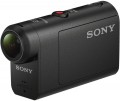Digital stabilization
The presence of a digital (electronic) stabilization system in the camera design.
Any stabilization is intended to compensate for small juddering of the image that occurs due to the instability of the hold in the hands, vibrations from the motor or road roughness (when used in transport), etc.
Digital stabilization is carried out as follows: a reserve area is allocated along the edges of the sensor, which under normal conditions does not participate in the formation of the final image. If the device is being shaken, the camera electronics select certain parts of the image from the reserve and build the image in such a way that in the end, it remains stable.
Compared to other methods of stabilization, digital systems are extremely simple and reliable. Moreover, they are inexpensive and have almost no effect on the weight, dimensions, and price of the camera. At the same time, with this method of stabilization, the effective area of the image sensor is reduced, which can adversely affect the image quality and the amount of noise on it.
Optical stabilization
The presence of an optical stabilization system in the design of the camera.
Any stabilization is intended to compensate for small juddering of the image that occurs due to the instability of the hold in the hands, vibrations from the motor or road roughness (when used in transport), etc.
Optical stabilization is carried out by a system of movable lenses and gyroscopes in the camera lens; such a system monitors the vibrations of the device and adjusts the optics in such a way that the image falling on the sensor remains motionless.
The optical method is considered more advanced than the electronic method described above: it allows you to use the entire area of the image sensor, which contributes to good image quality. At the same time, the stabilization mechanism turns out to be quite complex and expensive, and often quite fragile. In addition, it increases the weight and dimensions of the entire device — not by much, but sometimes this may be important. And the miniaturization of such systems further affects the price. As a result, the presence of an optical stabilizer is most often a sign of a fairly advanced camera.
Connection
—
GPS module. Built-in satellite navigation module that allows you to determine the current coordinates of the device. Options for using data from GPS can be different: geotagging footage, recording travelled routes, determining the speed of movement, or even full-fledged navigation on the map.
—
Wi-Fi module. The Wi-Fi wireless module in action cameras can be used in different formats: in some models, it is responsible for connecting to the Internet, in others it is for communicating with a smartphone or other gadget, in others both options are available at once. Anyway, the main use of this connection is to transfer footage to an external device or to the Internet (including broadcasting in the online streaming format, see “Filming capabilities”). In addition, more specific functions can be provided, for example, using a smartphone as an external viewfinder and remote control. Specific features of the use of Wi-Fi in each case should be clarified separately.
—
Bluetooth. Direct wireless communication technology for exchanging information between two electronic devices. In action cameras, it is most often used to connect remote controls, selfie sticks and smartphones, which can also act as a remote control. Unlike the Wi-Fi module, it consumes battery power more economically, but at the same time, the range of wireless communication is reduced to 10 m
...etres.
— NFC chip. NFC is a wireless communication technology over short distances (up to 10 cm). In action cameras, this technology is mainly used as an auxiliary one, to facilitate connection with a smartphone or other gadget via Wi-Fi or Bluetooth. If such a gadget is also equipped with NFC, just bring the camera to it and confirm the connection — it's easier than fiddling with the settings.
— USB-C. A relatively new type of USB interface that uses a miniature double-sided connector, slightly larger than microUSB. Most often used for similar purposes — as a universal connector through which you can charge the battery and connect the camera to a computer (for copying photos and videos, updating software, etc.). P.). At the same time, USB-C provides a higher data transfer rate than microUSB, supports more power supply, and also has a more convenient plug. Occasionally, there are more specific ways to use this interface — for example, direct connection to a smartphone or tablet that has a USB-C port.
— HDMI output. HDMI is a digital interface specially designed for high-definition video and multi-channel audio. With this output, you can connect the camera to a TV, monitor or other device as an external player and play the footage directly. The convenience of HDMI is that almost all modern video equipment with support for HD standards is equipped with such inputs.
Note that the cameras can be equipped with a smaller version of the connector — miniHDMI or microHDMI; however, finding an adapter cable is usually not a problem, it can even be supplied in the kit.
— Microphone connection. Almost any modern action camera has a built-in microphone that allows you to record sound. However, the quality of its sound is often quite low. Thus, many models can connect an external microphone — you can fix it, for example, on the helmet strap and record the comments of the athlete in the process of movement. Note that different types of connectors can be used for such a connection. As a result, the specific connector type and supported accessories depend on the action camera model, and some devices are only compatible with branded microphones.
